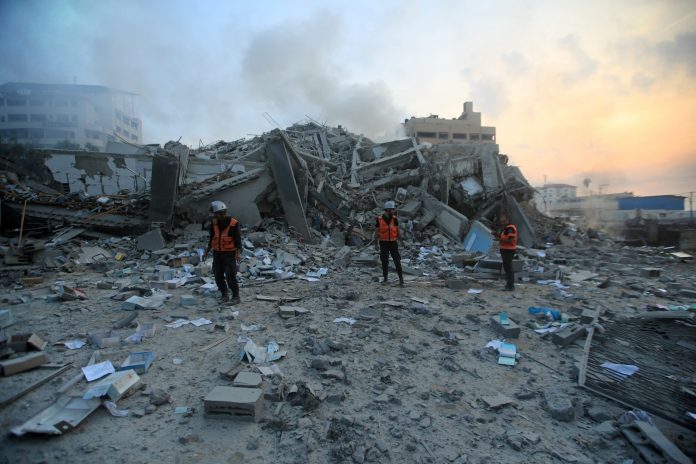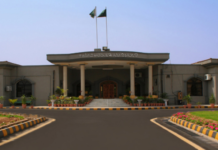——- Tel Aviv continues to carry out attacks on Rafah and Gaza
——- Israeli tanks push into Gaza from north and south
——- Hundreds of thousands of people are being forced to flee again after being pushed south by fighting elsewhere
DM Monitoring
CAIRO: Israeli forces pushed deep into the ruins of Gaza’s northern edge on Monday to recapture an area where they claimed to have dismantled Hamas months ago, while in the south tanks and troops pushed across a highway into Rafah.
Some of the most intense fighting for weeks is raging in both the north and south. Israeli operations in Rafah, which borders Egypt, have closed a main crossing point for aid, which humanitarian groups say is worsening an already dire situation. Hundreds of thousands of people are being forced to flee again after around half of Gaza’s population took sanctuary there after being pushed south by fighting elsewhere. Gaza’s health authority on Monday appealed for international pressure to reopen access via the southern border to allow in aid and medical supplies.
“The wounded and sick suffer a slow death because there is no treatment and supplies and they cannot travel,” it said.
In northern Gaza’s Jabalia, a sprawling refugee camp built 75 years ago to house Palestinian refugees from what is now Israel, tanks pushed towards the heart of the district.
Residents fled along rubble-strewn streets carrying bags of belongings. Tank shells landed in the centre of the camp and airstrikes destroyed clusters of houses, they said. Health officials said they had recovered 20 bodies of Palestinians killed in overnight airstrikes.
“We don’t know where to go. We have been displaced from one place to the next… We are running in the streets. I saw it with my own eyes. I saw the tank and the bulldozer. It is on that street,” said one woman, who did not give her name.
Israel’s military said in early January that it had “dismantled Hamas’ military framework in Jabalia”, although it expected to return to the area periodically to fight resistance fighters.
Palestinians say the need to return to earlier battlegrounds is proof Israel’s military objectives are unattainable.
Israeli troops are seeking to wipe out Hamas, which has said it is committed to Israel’s destruction. The group burst into Israel on Oct. 7, killing 1,200 and taking more than 250 hostages, by Israeli tallies.
Attending a Memorial Day ceremony to mark Israel’s fallen soldiers in Jerusalem on Monday, Prime Minister Benjamin Netanyahu said the war against Hamas is a struggle to secure Israel’s “existence, liberty, security and prosperity.”
“Our war of independence is not over yet, it continues to these days,” he said.
The Palestinian death toll in the war has now surpassed 35,000, with 57 killed in the past 24 hours, according to Gaza health officials, whose figures do not differentiate between civilians and fighters.
The fighting has laid waste to the enclave and caused a deep humanitarian crisis, with the Gaza health ministry warning on Monday that the medical system is on the verge of collapse due to a shortage of fuel to power generators and ambulances.
In Rafah, Israel stepped up aerial and ground bombardments on the eastern areas of the city, killing people in an airstrike on a house in the Brazil neighbourhood.
Israel ordered residents out of the east of Rafah last week, and extended that order to central areas in recent days, sending hundreds of thousands of people fleeing in search of safety.
Residents said Israeli air and ground bombardments were intensifying and tanks had cut off the main north-south Salahuddin Road dividing east of the city from the central area.
“The tanks cut the Salahuddin road east of the city, the forces are now in the southeast side, building up near the built-up area. The situation is dreadful and the sounds of explosions never stopped,” said Bassam, 57, from the Shaboura neighbourhood in Rafah.
“People continue to leave Rafah…no place looks safe now and people do not want to escape at the last minute should tanks make sudden incursions and moving out becomes too late,” he told Reuters via a chat app.
UNRWA, the main United Nations aid agency in Gaza, estimated that about 360,000 people had fled the southern city since the Israeli military gave its first evacuation order a week ago.
In Gaza city, Al-Ahli Arab Hospital medics said five people were killed in an airstrike on a house.
The assault on Rafah has caused one of the biggest splits in decades between Israel and its main ally the United States, which paused some deliveries of weapons for the first time since the war began. Washington says Israel must not assault Rafah without a plan to protect civilians, which it has yet to see.
Israeli Defence Minister Yoav Gallant’s office said on Monday he had briefed US Secretary of State Antony Blinken on the “precise operation” in the Rafah area.
Jack Lew, the US ambassador to Israel, signalled on Sunday that the Rafah incursion was still on a scale that Washington considers acceptable.
Hamas’ armed wing said its fighters were engaged in gun battles with Israeli forces in one of the streets east of Rafah, and in the east of Jabalia.
In Israel, the military sounded sirens several times in areas near Gaza, warning of potential Palestinian cross-border rocket and or mortar launches.
Hamas and the armed wing of Islamic Jihad said in a joint statement that they fired mortar bombs against Israeli forces massing inside the Rafah crossing, which Israel captured last week.



